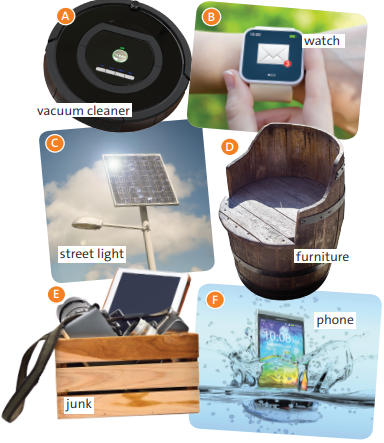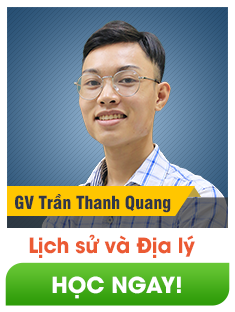Tiếng Anh 8 Unit 4 Vocabulary and listening: Adjectives (describing objects)THINK! Who do you think should be responsible for finding solutions to world problems? 1. Listen to the adjectives in the box then under the stressed syllable in each word. 2. Look at photos A - F. Use the adjectives in exercise 1 to describe the objects. 3. Listen to a radio programme about unusual shoes. Why are the shoes unusual? 4. Listen again and complete the sentences with the correct adjectives in exercise 1. Tổng hợp đề thi học kì 2 lớp 8 tất cả các môn - Chân trời sáng tạo Toán - Văn - Anh - Khoa học tự nhiên
Lựa chọn câu để xem lời giải nhanh hơn
Think! THINK! Who do you think should be responsible for finding solutions to world problems? (Bạn nghĩ ai nên chịu trách nhiệm tìm giải pháp cho các vấn đề của thế giới?) Lời giải chi tiết: I think every individual is responsible for finding solutions to world problems. Come to think of it, these issues emanate from the actions of each individual hence taking up responsibility, managing your activities as an individual goes a long way in solving them. (Tôi nghĩ mỗi cá nhân đều có trách nhiệm tìm giải pháp cho các vấn đề của thế giới. Hãy nghĩ về nó, những vấn đề này bắt nguồn từ hành động của mỗi cá nhân, do đó việc chịu trách nhiệm, quản lý các hoạt động của bạn với tư cách là một cá nhân sẽ đi một chặng đường dài trong việc giải quyết chúng.) Bài 1 1. Listen to the adjectives in the box then under the stressed syllable in each word. (Nghe các tính từ trong hộp sau đó nhấn trọng âm trong mỗi từ.)
Lời giải chi tiết: - automatic (adj): tự động - digital (adj): kỹ thuật số - ecological (adj): sinh thái - electronic (adj): thuộc điện tử - hi-tech (adj): công nghệ cao - home-made (adj): làm tại nhà - multi-functional (adj): đa chức năng - natural (adj): tự nhiên - recycled (adj): tái chế - second-hand (adj): hàng hóa cũ, mặt hàng đã được sử dụng - smart (adj): thông minh - solar (adj): thuộc mặt trời, năng lượng mặt trời - useful (adj): hữu ích - waterproof (adj): không thấm nước Bài 2 2. Look at photos A - F. Use the adjectives in exercise 1 to describe the objects. (Nhìn vào các hình A - F. Sử dụng các tính từ trong bài tập 1 để mô tả các món đồ.)
Lời giải chi tiết: A. automatic vacuum cleaner (máy hút bụi tự động) B. digital/ smart watch (đồng hồ kỹ thuật số/ thông minh) C. solar/ electronic streetlight (đèn đường năng lượng mặt trời/ điện tử) D. recycled furniture (nội thất được tái chế) E. second - hand junk (phế liệu cũ) F. waterproof phone (điện thoại chống nước) Bài 3 3. Listen to a radio programme about unusual shoes. Why are the shoes unusual? (Nghe một chương trình phát thanh về những đôi giày khác thường. Tại sao những đôi giày là khác thường?)
Phương pháp giải: Bài nghe: Julie: Welcome back to Material world. Now, today we won't be talking about the latest electronic equipment, multi-functional gadgets, smart fabrics, automatic cars or even solar cars. Instead, we'll be looking at very special ecological shoes. These could help children in the developing world, in addition to helping the environment. Let's find out more with our consumer correspondent, Murray Roberts. Murray: Hello, Julie. Julie: Hello, Murray. Tell us a little about the problem first. Murray: Well, it's a sad fact that there are millions of children in the world who don't have shoes. And there are lots of children who do have them but still have problems. That's because the shoes are second-hand, and too big or too small for their feet. Julie: But you have found a solution, haven't you? Murray: Yes. Inventor Kenton Lee is the director of a company that produces shoes that can increase or decrease in size. Julie: That sounds a bit hi-tech, doesn't it? How does it work? Murray: It's not hi-tech at all really. You don't always need digital technology to solve a problem. It works by making simple changes to the shoe. If you change the position of the front and side parts, they will either get bigger or smaller. Julie: So, children can use them for several years as their feet grow, can't they? Murray: Yes, for up to five years. Julie: But how's that possible? One shoe won't fit everyone, will it? Murray: The shoes have two sizes. Small is for children between five and ten years of age. Large is for older children between ten and fifteen. Julie: That's really useful, isn't it? These kids can probably do a lot more in their lives than they could before... go to school, play, that kind of thing. Murray: Yes, exactly! Julie: Can the kids use them for running around as well? I mean, are they practical? Murray: Yes. Well, they aren't waterproof, but children can use them to walk, run, play ... whatever they want. Julie: At the moment, people are wearing them in Ecuador, Haiti, Ghana and Kenya, aren't they? Murray: Yes, that's right. And the company is planning to get them to many more countries, too. Julie: Murray, thank you very much. Now on to our next story, about clothes made from recycled and natural materials, which you can... Tạm dịch: Julie: Chào mừng trở lại với thế giới Vật chất. Bây giờ, hôm nay chúng ta sẽ không nói về thiết bị điện tử mới nhất, thiết bị đa chức năng, vải thông minh, ô tô tự động hay thậm chí là ô tô năng lượng mặt trời. Thay vào đó, chúng ta sẽ xem xét những đôi giày sinh thái rất đặc biệt. Những thứ này có thể giúp ích cho trẻ em ở các nước đang phát triển, ngoài việc giúp ích cho môi trường. Hãy cùng tìm hiểu thêm với phóng viên tiêu dùng của chúng tôi, Murray Roberts. Murray: Xin chào, Julie. Julie: Xin chào, Murray. Hãy cho chúng tôi biết một chút về vấn đề đầu tiên. Murray: Chà, có một sự thật đáng buồn là có hàng triệu trẻ em trên thế giới không có giày. Và có rất nhiều trẻ em có chúng nhưng vẫn có vấn đề. Đó là bởi vì đôi giày đã qua sử dụng và quá to hoặc quá nhỏ so với chân của họ. Julie: Nhưng bạn đã tìm ra giải pháp rồi phải không? Murray: Vâng. Nhà phát minh Kenton Lee là giám đốc của một công ty sản xuất giày có thể tăng hoặc giảm kích cỡ. Julie: Điều đó nghe có vẻ hơi công nghệ phải không? Làm thế nào nó hoạt động? Murray: Nó thực sự không phải là công nghệ cao. Không phải lúc nào bạn cũng cần công nghệ kỹ thuật số để giải quyết vấn đề. Nó hoạt động bằng cách thực hiện những thay đổi đơn giản cho giày. Nếu bạn thay đổi vị trí của các phần phía trước và bên, chúng sẽ lớn hơn hoặc nhỏ hơn. Julie: Vậy, trẻ em có thể sử dụng chúng trong vài năm khi chân chúng lớn lên, phải không? Murray: Có, cho đến năm năm. Julie: Nhưng làm thế nào mà có thể? Một chiếc giày sẽ không phù hợp với tất cả mọi người, phải không? Murray: Đôi giày có hai cỡ. Nhỏ dành cho trẻ em từ năm đến mười tuổi. Lớn dành cho trẻ lớn hơn từ mười đến mười lăm tuổi. Julie: Điều đó thực sự hữu ích phải không? Những đứa trẻ này có lẽ có thể làm được nhiều điều hơn trong cuộc sống của chúng so với trước đây... đi học, chơi, đại loại như vậy. Murray: Vâng, chính xác! Julie: Bọn trẻ có thể sử dụng chúng để chạy xung quanh không? Ý tôi là, chúng có thực tế không? Murray: Vâng. Chà, chúng không thấm nước, nhưng trẻ em có thể sử dụng chúng để đi, chạy, chơi ... bất cứ thứ gì chúng muốn. Julie: Hiện tại, mọi người đang mang chúng ở Ecuador, Haiti, Ghana và Kenya phải không? Murray: Vâng, đúng vậy. Và công ty cũng đang có kế hoạch đưa chúng đến nhiều quốc gia khác. Julie: Murray, cảm ơn bạn rất nhiều. Bây giờ chuyển sang câu chuyện tiếp theo của chúng ta, về quần áo làm từ vật liệu tự nhiên và tái chế, mà bạn có thể... Lời giải chi tiết: Because they get bigger or smaller, so poor children who can’t afford new shoes can wear them. (Vì chúng có thể trở nên lớn hơn hoặc bé hơn, nên những đứa trẻ nghèo không có đủ tiền mua giày mới có thể mang chúng.) Bài 4 4. Listen again and complete the sentences with the correct adjectives in exercise 1. (Nghe lại và hoàn thành các câu với các tính từ đúng trong bài tập 1.)
1. Murray talks about special shoes that can help children and are _______ at the same time. 2. A lot of children have problems because they wear __________ shoes which are not the right size for their feet. 3. Murray says that the shoes are very simple and not __________ at all. 4. The shoes are practical and useful, but they aren't ____________. 5. The next story will be about clothes made from __________ and natural materials. Lời giải chi tiết:
1. Murray talks about special shoes that can help children and are ecological at the same time. (Murray nói về những đôi giày đặc biệt có thể giúp ích cho trẻ em và đồng thời thân thiện với môi trường.) 2. A lot of children have problems because they wear second-hand shoes which are not the right size for their feet. (Rất nhiều trẻ em gặp vấn đề vì đi giày cũ không đúng cỡ chân.) 3. Murray says that the shoes are very simple and not hi-tech at all. (Murray nói rằng đôi giày rất đơn giản và không có chút công nghệ cao nào.) 4. The shoes are practical and useful, but they aren't waterproof. (Đôi giày thiết thực và hữu ích, nhưng chúng không thấm nước.) 5. The next story will be about clothes made from recycled and natural materials. (Câu chuyện tiếp theo sẽ là về quần áo làm từ vật liệu tái chế và tự nhiên.) Bài 5 5. Which of these statements taken from the listening are fact (F) and which are opinion (O)? How do you know? (Câu nào trong số những câu sau đây lấy từ bài nghe là sự thật (F) và câu nào là ý kiến (0)? Làm sao bạn biết?) 1. There are millions of children in the world who don’t have shoes. 2. That sounds a bit hi-tech. 3. That's really useful, isn’t it? 4. At the moment, people are wearing them in Ecuador. Lời giải chi tiết: 1. F There are millions of children in the world who don’t have shoes. (Có hàng triệu trẻ em trên thế giới không có giày.) 2. O That sounds a bit hi-tech. (Nghe có vẻ khá là công nghệ cao.) 3. O That's really useful, isn’t it? (Điều đó thực sự hữu ích phải không?) 4. F At the moment, people are wearing them in Ecuador. (Hiện tại, mọi người đang mặc / đi chúng ở Ecuador.) => the adjective “useful” expresses an opinion (tính từ “hữu ích” thể hiện ý kiến) Bài 6 6. USE IT! Work in groups. Think of an invention that can help people. Then ask and answer questions using the key phrases. Whose object is the most useful? (Làm việc nhóm. Hãy nghĩ về một phát minh có thể giúp mọi người. Sau đó đặt và trả lời các câu hỏi bằng các cụm từ chính. Cái của ai là hữu ích nhất?) A: My object's an electronic skateboard. We invented it to get to places quickly. (Đối tượng của tôi là một chiếc ván trượt điện tử. Chúng ta đã phát minh ra nó để đến các địa điểm một cách nhanh chóng.) B: That sounds cool. Can you use it for getting to school? (Nghe có vẻ tuyệt. Bạn có thể sử dụng nó để đến trường không?) A: Yes. You can use it to go... (Đúng. Bạn có thể sử dụng nó để đi...) Phương pháp giải:
Lời giải chi tiết: A: My object’s an electronic notebook. We invented it to write and study more conveniently. It limits erasing and makes it easy to synthesize knowledge and review lessons. (Đối tượng của tôi là một cuốn sổ điện tử. Chúng tôi đã phát minh ra nó để viết và học tập thuận tiện hơn. Nó hạn chế việc tẩy xóa và giúp bạn dễ dàng tổng hợp kiến thức và ôn tập bài học.) B: That sounds useful. Can I use it to take notes and highlight? (Điều đó nghe có vẻ hữu ích. Tôi có thể sử dụng nó để ghi chú và đánh dấu không?) A: Yes. You can use it to study easily. (Vâng. Bạn có thể sử dụng nó để học một cách dễ dàng.)
|




















